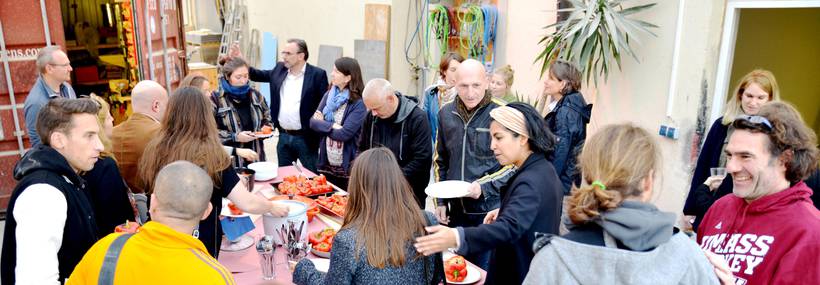EMPFANGSHALLE was founded in 2001 by the artist duo Corbinian Böhm and Michael Gruber and since then has made a name for itself for art in public space.
This artist duo has developed an expanded concept of art based on communication and cooperation. Through this new form, which also includes cooperation in practical matters, a solid company structure has emerged. A network of over 30 independent artists make up the backbone of EMPFANGSHALLE. Jointly used studios make possible living and working for a synergetic network of artists.
In addition to free-standing works of art, EMPFANGSHALLE also carries out crafts commissions with artistic standards. The range of their crafts commissions extends from film and theatre sets to accoutrements for churches. This creative-economy collective has stood for the highest artistic quality for many years.
Art projects, exhibitions and applied-arts commissions are carried out collectively. Lively exchange is part and parcel of everyday life, in particular during the numerous events where the art scene regularly gathers.
EMPFANGSHALLE’s studios are one of Munich’s liveliest cultural venues.
Open Studios, Artists’ Lunches, Exhibitions and Residency:
EMPFANGSHALLE stands for an open structure for one and all.
-Artists invite the public to exhibitions in their studio spaces.
-For “Artists’ Lunches,” one artist cooks a lunch for the entire collective, including extended cultural circles. At these events, the artist introduces himself and presents his work.
-The EMPFANGSHALLE premises function as a branch of the urban Munich gallery FOE.
– As part of the concept behind the EMPFANGSHALLE studio, exhibitions are made possible in cooperation with established institutions, such as the Pinakothek der Moderne, the Kunstverein München e.V. and exhibition spaces managed by the City of Munich.
-A residency programme for visiting artists from abroad enables international exchange with colleagues and institutions.
– Gallery owners, craftspeople, curators, art agents and educators, authors, art historians, stage designers, architects, students and professors from the Munich Academy of Fine Arts, cultural producers, for instance from the Goethe-Institut, the Munich Office of Cultural Affairs, and many more.
The EMPFANGSHALLE studio’s creative-economy structure:
Applied-arts projects have become a reliable mainstay, so that the EMPFANGSHALLE studio is able to support itself independently of subsidies.
These commissions are just as demanding and interesting as purely artistic ones. Thus, for example, the ice landscape for “Wickie2” arose in the Bavaria Filmstudios and a 12-metre long dragon for the stage set for “Siegfried” at the Münchner Volkstheater.
Many artists collaborate on these diverse projects and in doing so earn a regular income. It is a definite advantage that the artists of the EMPFANGSHALLE studio bring a wide range of skills and talents.
They work with the most up-to-the-minute materials, and in the process, many artistic techniques have been developed and redeveloped in new ways.The well-equipped workshops are open to all artists from the network to realise both their own projects and commissioned work.
Support for young artists:
Within the timeframe of an internship an application portfolio for the Academy of Fine Arts is developed and in addition, through their collaboration on projects, young artists gain a deeper understanding of artistic, crafts and market processes.
EMPFANGSHALLE also offers training in scene painting and set construction.
EMPFANGSHALLE has had a lectureship for sculpture and figure sculpting at the Academy of Fine Arts for many years.
-

Artists' Lunches

